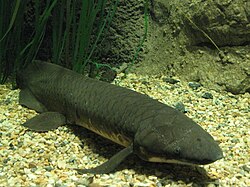and longshore drift, primarily to enforce coastal structures such as seawalls and breakwaters. Tetrapods are made of concrete, and use a tetrahedral shape...
5 KB (628 words) - 15:54, 24 January 2025
Homology (biology) (redirect from Homologous structure)
like horses and crocodilians are all derived from the same ancestral tetrapod structure. In developmental biology, organs that developed in the embryo in...
40 KB (4,069 words) - 20:34, 12 May 2025
Tetrapod may also refer to: Tetrapod (structure), a type of structure used to prevent erosion in coastal engineering Tetrapod (table) or analogion, a lectern...
522 bytes (105 words) - 03:12, 5 April 2021
A tetrapod (/ˈtɛtrəˌpɒd/; from Ancient Greek τετρα- (tetra-) 'four' and πούς (poús) 'foot') is any four-limbed vertebrate animal of the clade Tetrapoda...
106 KB (10,756 words) - 20:19, 17 June 2025
Tiktaalik (category Evolution of tetrapods)
about 375 Mya (million years ago), having many features akin to those of tetrapods (four-legged animals). Tiktaalik is estimated to have had a total length...
58 KB (6,000 words) - 01:06, 10 June 2025
locally available rock. Shaped concrete armour units (such as Dolos, Xbloc, Tetrapod, etc.) can be provided in up to approximately 40 tonnes (e.g. Jorf Lasfar...
16 KB (1,916 words) - 07:00, 9 June 2025
adult fish, these support the gills, while in adult tetrapods they develop into other structures. In the embryo, a layer of cells along the back folds...
48 KB (4,039 words) - 20:15, 24 May 2025
evolution of tetrapods began about 400 million years ago in the Devonian Period with the earliest tetrapods evolved from lobe-finned fishes. Tetrapods (under...
67 KB (7,973 words) - 00:52, 7 June 2025
internal skeleton. Lungfish represent the closest living relatives of the tetrapods (which includes living amphibians, reptiles, birds and mammals). The mouths...
44 KB (3,952 words) - 14:29, 24 May 2025
Leg (section Tetrapod legs)
as dogs and horses Many taxa are characterized by the number of legs: Tetrapods have four legs. Squamates of genus Bipes have only two. Caecilians and...
6 KB (632 words) - 07:39, 4 June 2025
Limbless vertebrate (redirect from Legless tetrapod)
forelimb structure and forelimb initiation gene network. A. The moa..." ResearchGate. Retrieved 2020-08-25. Gans, Carl (1975-05-01). "Tetrapod Limblessness:...
8 KB (914 words) - 01:10, 10 June 2025
Marine vertebrate (redirect from Marine tetrapod)
saltwater fish (including pelagic, coral and deep sea fish) and marine tetrapods (primarily marine mammals and marine reptiles, as well as semiaquatic...
31 KB (3,196 words) - 16:22, 15 June 2025
Ichthyostega (category Evolution of tetrapods)
Ichthyostega is often labelled a 'tetrapod' because of its limbs and fingers, it evolved long before true crown group tetrapods and could more accurately be...
17 KB (1,434 words) - 01:10, 10 June 2025
Amniotes are tetrapod vertebrate animals belonging to the clade Amniota, a large group that comprises the vast majority of living terrestrial and semiaquatic...
49 KB (3,970 words) - 17:08, 11 June 2025
Nail (anatomy) (section Structure)
(fingers and toes) of all primates, corresponding to the claws in other tetrapod animals. Fingernails and toenails are made of a tough rigid protein called...
34 KB (4,212 words) - 03:07, 21 June 2025
Brain (redirect from Brain structure)
reptiles have diverged in terms of external morphology, from limbless to tetrapod gliders to armored chelonians, reflecting adaptive radiation to a diverse...
133 KB (15,771 words) - 18:10, 17 June 2025
dentin), and external keratin. The physical structure of tetrapodomorphs, fish bearing resemblance to tetrapods, provides valuable insights into the evolutionary...
43 KB (3,361 words) - 05:39, 2 June 2025
small internal loops. RNA secondary structure applies in RNA splicing in certain species. In humans and other tetrapods, it has been shown that without the...
22 KB (2,690 words) - 12:55, 20 June 2025
Actinistia. As sarcopterygians, they are more closely related to lungfish and tetrapods (the terrestrial vertebrates including living amphibians, reptiles, birds...
72 KB (6,678 words) - 02:40, 17 June 2025
Pederpes (category Carboniferous tetrapods)
terrestrially adapted Carboniferous forms. Pederpes is the earliest-known tetrapod to show the beginnings of terrestrial locomotion and despite the probable...
5 KB (544 words) - 10:51, 19 February 2025
Panderichthys is not a direct ancestor of tetrapods, but nonetheless shows the traits that evolved during the fish-tetrapod evolution. Panderichthys is represented...
22 KB (2,824 words) - 12:17, 11 June 2025
reported trackways of the earliest land-going vertebrates, also known as tetrapods. These trackways provide crucial insights to the study of the transition...
9 KB (1,175 words) - 12:12, 24 May 2025
Convergent evolution (redirect from Analogous structure)
homologous limbs because they are both ultimately derived from terrestrial tetrapods, but their flight mechanisms are only analogous, so their wings are examples...
59 KB (5,817 words) - 19:16, 21 May 2025
Temnospondyli (category Prehistoric tetrapod orders)
'vertebra') or temnospondyls is a diverse ancient order of small to giant tetrapods—often considered primitive amphibians—that flourished worldwide during...
172 KB (17,737 words) - 06:31, 19 June 2025
Timeline of fish evolution (section Fish to tetrapods)
fish, their Devonian radiation, including the conquest of land by early tetrapods, and the post-Devonian evolution of fishes. The Devonian period is broken...
120 KB (6,310 words) - 10:49, 22 June 2025
Dactyly (section Aquatic tetrapods)
digits (fingers and toes) on the hands, feet, or sometimes wings of a tetrapod animal. The term is derived from the Greek word δακτυλος (dáktylos) meaning...
17 KB (1,938 words) - 13:55, 14 June 2025
(excluding tetrapods) in size. Fish in the common usage are a paraphyletic group that describes aquatic vertebrates while excluding the tetrapods, four limbed...
105 KB (11,528 words) - 19:07, 22 June 2025


























